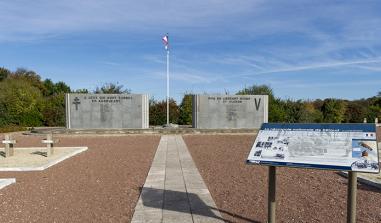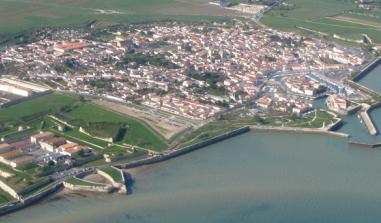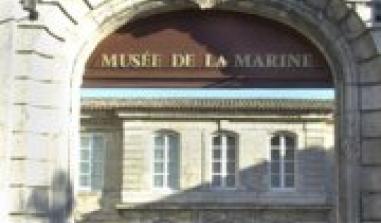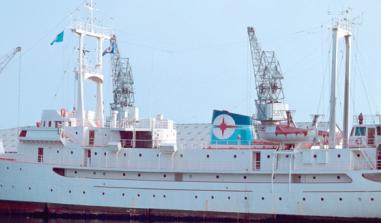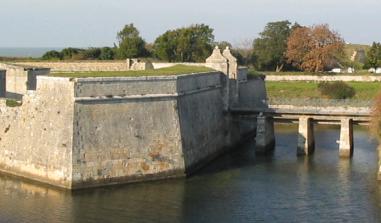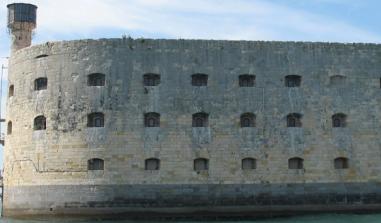The former School of Naval Medicine in Rochefort
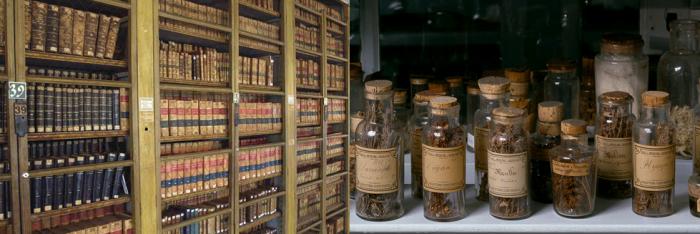
This school displays the library and collections that have been assembled since the 18th century for use by surgeons on board ships.
The Naval School of Medicine still looks the same today as it did in the middle of the 19th Century. The objects, works and the way the information is displayed, categorised and staged are just as scholars and doctors 150 years ago wanted. For 20th century visitors, the School of Medicine is primarily a place where they can experience a tangible contact with an exceptionally well preserved scientific imagination. It is a strong, emotional place, opening the doors to a dense history where science, technology, politics and society merge. It provides a glimpse of a state of knowledge that we have inherited. They are the footprints of human endeavour, through which sailors and navy surgeons contributed to breaking down taboos in order to unlock the secrets of the human body and grasp the living world in all its diversity. The history of the place The former School of Naval Medicine is located in a wing of the second Naval Hospital, which opened in Rochefort in 1788. Through its architecture, the building exhibits the latest developments in medicine with regard to the spread of diseases. In this respect it constitutes the first French attempt at multi-wing hospital architecture. It also demonstrates urban concerns in opening up a broad perspective that still influences the development of the town today.
The first naval hospital was opened in 1683, close to the naval shipyard and near the food store. It was inside its walls that Jean Cochon-Dupuy's School of Surgery was established in 1722. The building, still known today as the Charente Hospital, was gradually incorporated into the town. As it became surrounded by houses, it was the cause of numerous problems with epidemics. Typhoid and other fevers that the sailors brought back from their expeditions were transmitted to other patients and regularly spread to the general public. In the 1770's, medicine became concerned about air quality, its chemical composition and its role in spreading diseases. Too cramped and exposed to the unhealthy air from the marshland on which Rochefort is built, the hospital also presented a major fire hazard in the town centre: the destruction of the Hôtel-Dieu de Paris in 1772 stuck in people's minds. As a result, in 1781 the king decided to build a new hospital. Pierre Toufaire, the engineer in charge of works on the port, designed a large scale project, on an enormous H-shaped blueprint comprising a central main building flanked by four wings, with the façade completed by two other wings. These wings were designed to contain patients with the same diseases in order to prevent their transmission. In addition, the skylight above the main building and the wide windows and dormers that let in sunlight created the circulation of air that was vital for the hygienists of the day. In terms of departments, Toufaire planned a rational organisation of the areas allocated to offices, doctors' bedrooms, chapels, treatment rooms and patient reception, as well as areas for training the sea-faring surgeons, who had the use of a theatre, an anatomy laboratory and a library. The Hospital was eventually supplied with running water via a fire hydrant and a system of waste water drainage. It was thus a model Hospital and the most modern in the Kingdom. Topographically, the Hospital is located outside the town centre on a small promontory that looks out over the flat Rochefort countryside. For this reason, it was known for a time as the Hôpital de la Butte (Hospital on the Mound). Toufaire included the building in a plan that linked it with the church of Notre-Dame, also called the Vieille Paroisse (currently the Archaeological Museum), thus opening up an enormous urban swathe that would become the Cours d'Ablois. Even today, after the demolition of the ramparts, this urban programme still influences the development of Rochefort. In use until 1983, the Naval Hospital was privatised in 1989. Only the Wing of the Former School of Medicine is now open to the public.
The school: a historical place Throughout the 17th Century, at the same time as a permanent navy was created in France, it was standard practice to have a surgeon on board warships. Surgeon, a manual profession, was therefore strongly distinct from doctor, an intellectual profession. This sector often included former barbers who knew how to use a few cutting tools and whose expertise was more than cursory. However, the emerging Navy had serious sanitary problems: the living conditions, poor diet and contagious tropical diseases caused a very high mortality rate in the crews. Up until the beginning of the 19th century, sailors were more likely to die from disease than from the after effects of combat. The increased length of campaigns along with the shifting of conflicts to the other side of the Atlantic increased the problems and led to the appearance of a disease that was to become the symbol of naval morbidity: scurvy. For the Navy, preserving the lives of its marines was a major strategic issue. Curing, understanding and transmitting became a matter of State, which was necessary for the very existence of a war fleet, such was the recurrent difficulty to recruit competent marines. In 1704, Jean-Cochon Dupuy, Doctor of Medicine at the faculty of Toulouse and a doctor at the military hospital of La Rochelle, arrived in Rochefort as deputy doctor. He became head doctor in 1712. In 1715, he demonstrated the need to establish a training centre for the surgeons of the Navy. The naval school of anatomy and surgery was inaugurated in 1722. It was the first in the world. Based on this model, the navy opened two other establishments, in Toulon in 1725 and in Brest in 1731. Jean-Cochon Dupuy worked as a teacher and organiser. He wrote anatomy and surgery manuals and set up the every day operation of the School. Requirements for admission were to be over 14 years old, be able to write, shave and bleed and have healthy hands without any deformities. Boys from poor families could therefore be accepted and in this respect the School played an important social role. Students visited patients in the hospital, watched dissections, took apothecary training and followed internal medicine, surgery and botany lessons, which were essential at a time when pharmaceutical drugs came almost exclusively from plants. The degree course was 4 years. Within the school, progression was through passing examinations, a measure of the seriousness of the courses. On the death of Jean-Cochon Dupuy in 1757, his son Gaspard succeeded him and continued his organisational work. At sea, surgeons trained by the School had to fulfil a threefold role, as surgeon, doctor and pharmacist and the course developed accordingly. Above all, the School confirmed its role in caring for patients in the hospital, in training and in research, three functions that are similar to the missions of modern day University Hospitals. Pierre Cochon-Duvivier, the School's third Director from 1788 to 1814, was subject to the upheavals of the Revolution and the Empire. A health council, a sort of Naval Hospital Administration Council, was set up. The completely restructured School reaffirmed its fundamental missions of treatment, training and research. In 1798, it took the name of the School of Naval Medicine and the apothecaries became pharmacists. In 1803, former students of the schools of naval medicine were allowed to adopt the title of Doctor of Medicine by studying for a thesis at the faculty, an essential stage in the promotion of surgery. The curriculum followed that of the civilian schools.
In 1836, new regulations put the emphasis on exotic diseases, anatomy, surgery and naval hygiene in the study programme. Botany was also a speciality of Rochefort. In fact, the training programme was quite broad-based and endeavoured to turn health officials into professionals, whose knowledge lay somewhere between that of the encyclopaedic scientist of the Enlightenment and the highly specialised practices of today. The School was thus far more than just a medical arena, operating as a regional intellectual centre and a place where knowledge was gathered and disseminated. The works in the library and the ethnographic collections bear witness to this. The School was in contact with the whole of the European medical and scientific milieu. Understanding diseases, unlocking the secrets of the human body and improving operating techniques were all amongst its objectives when it was created: dissections, experiments and discussion were the driving forces of the continual quest for cures. It was in Rochefort in 1818 that the first French vaccine was administered, a few months after its development by Jenner; it was one of the School's directors, Amédé Lefebvre, who discovered the causes of lead poisoning in 1818; less dramatic but just as significant, several surgical instruments were designed or improved by doctors at the School. In 1890 the Bordeaux School for the Health Service was founded, close to a civilian faculty. The schools of Brest, Rochefort and Toulon became associated establishments where students completed their first year before transferring to Bordeaux. Between 1890 and 1963, the subsidiary schools operated with a certain uniformity. In 1964, the Rochefort School of Naval Medicine held its final course.
The Wing of the Former School of Medicine: a historical site The building, its library and its collections were managed by the Navy until the closure of the naval hospital in 1983. The Wing of the Former School of Medicine was donated to the Public Administrative Department of the National Navy Museum in 1986, who undertook its renovation. The School of Medicine opened to the public in 1998, entering a new phase in its history. The School of Naval Medicine is a unique place in France, with its library and anatomical, zoological, botanical and ethnological collections that were assembled in the 18th century to be used in training the surgeons on board ships. It is both a museum (its collections are of primary importance), a historic monument (today it is the only part of the former Naval Hospital of 1788 open to the public), a scientific library (its 25,000 works, of which many were printed before 1500, are available to everyone by appointment) and a place of remembrance (an area of discovery, learning and healing, engraved deeply in the history of the people of Rochefort and of the Navy). For the Navy, the fight against the diseases that ravaged its crews, of which scurvy is only the best known, was one major strategic issue. The voyages of discovery and their batches of samples bear witness to a slow learning process about other populations.
Former School of Naval Medicine of Rochefort 25, rue de l'Amiral Meyer 17300 Rochefort Tel.: + 33 (0) 5 46 99 59 57 E-mail: d.roland@musee-marine.fr [list]Guided tours, every day at 10:30 - Duration: 1:15 Adult: € 8 Reduced price: € 7 Under 26: 3 € [list]Guided discovery, daily at 14:00, 15:00 and 16:00 Adult: € 5 Reduced: € 4 Free for children under 26. [list]Closed annually on the 1st May, 25th December and the 1st and 31st January Getting there Rochefort-Saint Agnant Airport Rochefort Railway Station TGV to Surgères and SNCF bus service or change at La Rochelle A10 Motorway from Paris to Bordeaux, taking the Surgères or Saint-Jean-d'Angély Rochefort exit: follow signs for town centre
Practical information
25 rue de l'Amiral Meyer 17300
Rochefort
05 46 99 59 57
Visites guidées tous les jours à 10h30 Tarif adulte: 8€ Tarif réduit:7€ - de 26 ans: 3€ Visites découvertes tous les jours à 14h, 15h et 16h Tarif adulte: 5€ Tarif réduit: 4€ Visite découverte gratuite pour les - de 26 ans.
Fermé les 1er mai, 25 décembre, et du 1er au 31 janvier


